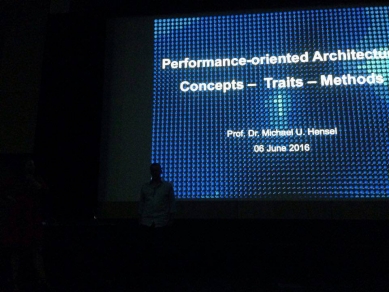
Architecture and Its Environment: Reflections on Michael Hensel's Lecture
On June 6, 2016, a lecture by the pioneer of Performative Architecture, co-founder of the Ocean Design Research Association, and professor at the Oslo School of Architecture and Design, Michael Hensel, took place at the Technical University in Liberec. The central theme was the relationship between architecture and the environment. The lecture began from the perspective of architecture that responds to its environment through its behavior, and ended with a discussion on a planned project on the vineyards of Bordeaux about living architecture that grows from its environment.
Michael outlined a shift towards architecture that is a full integral part of its environment from the standpoint of non-anthropocentric architecture encompassing both its living and non-living factors. Such an approach demands new tools and methods. Hensel, along with his colleague Sørensen, utilize local real-time data in their school design studio through Arduino and sensors, as well as simulations in virtual reality. In my opinion, such an approach holds significant potential for the environmentally focused methodology of Systems Oriented Design, discussed by his colleague Birger Sevaldson at TUL this March. Complex design while monitoring and simulating biotic and abiotic factors in an interdisciplinary team offers a step further in a creative environment, what is known as Rich Design Research Space.
Hensel is also a pioneer of the Research by Design method in full-scale prototyping. This method provides the best confrontation with one's own research through personal experience and monitoring the interaction of the prototype with the environment. Data is thus not only collected for design but also as feedback for further designs. Monitoring traditional architecture, which has been developed and tested over generations in direct relation to local environmental conditions, holds similar significance. Such measurements serve not only to monitor hard data but also to develop ingrained, even subconscious experiences and knowledge of the architect.
Humanity has always been part of its living and non-living environment, and for most of its history, architecture has had various levels of interactions or exchanges within its boundaries, whether it be courtyards, verandas, open or closed porches, arcades, balconies, passages, non-air-conditioned vestibules, or other indoor spaces. This onion principle of architecture allows for various levels of its habitation. Many of these insights have been forgotten and replaced by artificial environments that consume energy through ventilation and insulation. Current new technologies can help us return to a natural balance.
The lecture took place as part of the project Systemic Approach to Architectural Performance, with the kind support of EEA and Norwegian Funds.
Michael outlined a shift towards architecture that is a full integral part of its environment from the standpoint of non-anthropocentric architecture encompassing both its living and non-living factors. Such an approach demands new tools and methods. Hensel, along with his colleague Sørensen, utilize local real-time data in their school design studio through Arduino and sensors, as well as simulations in virtual reality. In my opinion, such an approach holds significant potential for the environmentally focused methodology of Systems Oriented Design, discussed by his colleague Birger Sevaldson at TUL this March. Complex design while monitoring and simulating biotic and abiotic factors in an interdisciplinary team offers a step further in a creative environment, what is known as Rich Design Research Space.
Hensel is also a pioneer of the Research by Design method in full-scale prototyping. This method provides the best confrontation with one's own research through personal experience and monitoring the interaction of the prototype with the environment. Data is thus not only collected for design but also as feedback for further designs. Monitoring traditional architecture, which has been developed and tested over generations in direct relation to local environmental conditions, holds similar significance. Such measurements serve not only to monitor hard data but also to develop ingrained, even subconscious experiences and knowledge of the architect.
Humanity has always been part of its living and non-living environment, and for most of its history, architecture has had various levels of interactions or exchanges within its boundaries, whether it be courtyards, verandas, open or closed porches, arcades, balconies, passages, non-air-conditioned vestibules, or other indoor spaces. This onion principle of architecture allows for various levels of its habitation. Many of these insights have been forgotten and replaced by artificial environments that consume energy through ventilation and insulation. Current new technologies can help us return to a natural balance.
The lecture took place as part of the project Systemic Approach to Architectural Performance, with the kind support of EEA and Norwegian Funds.
Marie Davidová, MArch.
Collaborative Collective
PhD student at FUA TUL
Scientific consultant at FLO|W studio, MOLAB – FA ČVUT
Collaborative Collective
PhD student at FUA TUL
Scientific consultant at FLO|W studio, MOLAB – FA ČVUT
The English translation is powered by AI tool. Switch to Czech to view the original text source.

0 comments
add comment












